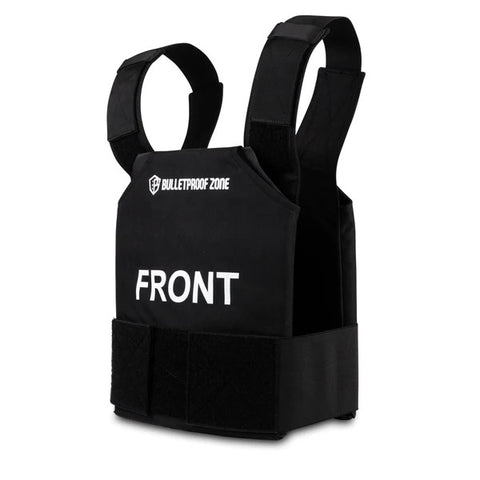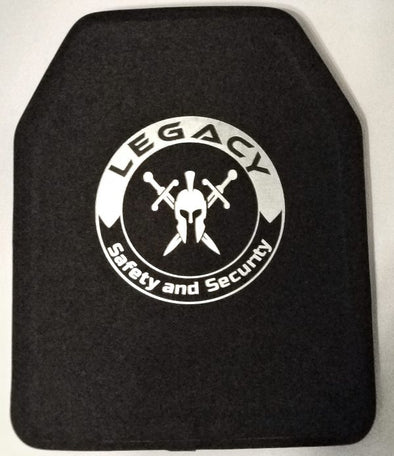The Top 7 Best Body Armor Plates for Any Situation
Are you looking for the best body armor plates and wondering where to start? There are so many options on the market that it can be overwhelming to know which ones are worth your time, especially when it's your first time trying to buy body armor.

There's a lot to consider before making your purchase, including materials, manufacturers, ballistic performance ratings (i.e., what type of bullets the gear's rated to withstand), weight/thickness, and your reason for wearing the armor.
What types of body armor should you even be considering for your particular purposes? In this article, we'll show you exactly what to look for when you're in the market for plates and share some of our top picks in the extensive Bulletproof Zone collection!
Buying Body Armor Plates - Considerations
When it comes to the best ballistic plates for you, the key things to keep in mind are :
Budget
There's no need to break the bank, but you also shouldn't skimp on quality when your life's at stake. That's why Bulletproof Zone offers a financing plan if you need it.
And if you happen to find gear you bought with us at a lower price elsewhere within six months after buying, we'll price match it.
NIJ certification
Every quality piece of body armor has an NIJ (National Institute of Justice) certification label on it. No label means no guarantee the armor was tested to rigorous standards, and you should steer clear.

NIJ protection level
All NIJ certified armor was able to withstand penetration from a certain range of ammunition during testing and receives an according NIJ level. Make sure to know what the NIJ levels mean before you buy. Then assess your threat level (the threat you're more likely to come up against) and get gear proven to handle it.
If handgun threats are your main risk (as they are for the average American), Level II armor or IIIA are your best bets. These come in the form of either a soft bulletproof vest or as soft armor inserts that slide into a carrier that you wear like a vest.
This kind of ballistic armor is relatively lightweight. In this category of armor, you can also find multi threat vests that offer protection against stabbing.
The Level II armor level protects against fewer types of handgun threats than Level IIIA.

Level III body armor and above resists rifle threats, with Level IV ceramic body armor rated to withstand most armor piercing rounds.
If you want to add green tip protection, there's the non-standard III+ rating. There's also special threat rated armor.
Hard armor comes only in the form of plates inserted into a plate carrier vest. It's much heavier, but, again, it's the only kind of armor rated to withstand rifle threats. Plus, a lot of manufacturers have begun to address the weight issue by producing lighter hard armor!
Material
One of the biggest debates in the armor world is what hard armor materials are "better." A steel plate, ceramic plate, or an ultra-high-molecular-weight polyethylene (UHMWPE) composite all have their own benefits and drawbacks.
Steel plates are cheaper and offer protection against armor piercing ballistics. The disadvantage of steel is that it's a bit heavier and thicker, which can make it uncomfortable to wear for long periods of time.
If you're only planning to wear body armor while at target practice or during short active shooter training sessions, steel plates are a good option.
Ceramic plates are slightly lighter than steel alloy armor, though they generally cost more. They're nearly as hard as diamond but are brittle compared to steel. They're effective at stopping one single powerful threat as opposed to multiple hits to the same spot.
UHMWPE (Ultra-High-Molecular-Weight Polyethylene) plates are much lighter than either ceramic or steel plates. They can take a lot of hits to the same area before obvious damage, but they don't currently come in Level IV for civilians. The price also runs a lot higher.
Cut
The four cuts or shapes of plates include:
Full Cut - shaped like a square or a rectangle. Often utilized as side protection, back plates, or backpack inserts.
Shooters cut - rectangle with four corners cut for better mobility when shooting. Most common cut, typically worn as a front plate.
Swimmers cut - more dramatic cut at the top corners for best arm and shoulder mobility. Less coverage than shooters cut. Used by teams or operatives who move fast and need unimpeded movement.
SAPI/ESAPI cut - in between full cut and shooters cut, shape-wise. Used by the military but are also popular in the civilian world for good reason. Prioritizes coverage rather than mobility.
Best Plates for Different Needs
The best bullet resistant armor is the one that satisfies your needs in terms of purpose, weight, NIJ rating, and customizability.
Below are our picks for plates or inserts that hit the sweet spot for a range of situations.
1. Best for Home Defense: Bulletproof Zone ProtectVest
The ProtectVest is the first soft armor plate carrier designed specifically for civilian use. It's easy to figure out and fast to put on, and it's as lightweight and comfortable as you can get.
Two Level IIIA soft armor panels slide into the carrier vest in less than 5 seconds -- unbeatable for anyone wanting body armor they can put on quickly in a home defense situation. The ProtectVest is also ideal for general everyday use.
Features:
-
protective - Tested to protect against handgun threats up to a .44 mag.
-
durable - 600D Cordura fabric carrier holds up and stays strong for years.
-
easy to use - Designed to be simple and easy to put on.
-
comfortable - Only 2.5 lbs. fully loaded. Elastic waist strap fits up to XL sizes.
Great for regular people:
-
at work
-
at home (for home defense situations)
-
at school or college
-
at festivals
-
on a road trip (folds up for easy storage)
-
in crime-heavy areas
2. Best for Active Shooter Situations: RMA Defense Level IV NIJ .06 Certified Hard Armor Plates
People like law enforcement officers and bodyguards have a greater chance of running into larger firearms and armor-piercing ballistics since it's their job to put themselves in harm's way if an active shooter situation arises. For a piece of stronger body armor that's up to the job, we recommend:
Made in the USA, the RMA Defense Level IV NIJ .06 Certified Hard Armor Plates are an ideal choice for anyone who might need protection against larger ballistics or firearms. This is the best-selling armor plate brand among law enforcement officers in the U.S.
Features:
-
highly protective - Multi-hit rated NIJ Level IV protection
-
durable -Monolithic ceramic and polyethylene; 600 denier water resistant cover
-
comfortable - SAPI/ESAPI-cut for better ventilation
Great for:
-
police officers
-
bodyguards
-
SWAT teams
3. Best Level III Lightweight Defense: ProtectVest® L3 Air - 10"X12" Extremely Lightweight Level III Bulletproof Vest
Sometimes weight is the priority. If you want rifle protection but also need to be light on your feet with the best mobility possible, there's an option for you!
When it comes to heavy-duty protection that won't weigh you down, the ProtectVest® L3 Air - 10"X12" Extremely Lightweight Level III Bulletproof Vest is at good as it gets. It's just as simple to use and easy to put on as the Level IIIA version, but it's designed and tested to withstand rifle threats.
Hard bulletproof panels slide straight down into the carrier vest for ease-of-use, and clearly marked sides show you the front and back of the vest at a glance.
Features:
-
lightweight - Ultra-high-molecular-weight polyethylene armor panels. Vest only 7 lbs. fully loaded.
-
protective - Tested to protect against rifle threats up to a 7.62 mm FMJ steel jacketed (SJ) round.
-
comfortable - Elastic waist strap adjusts to fit up to XL sizes.
-
durable - 600D Cordura fabric carrier stays strong for years.
Great for:
-
the office or workplace
-
home defense situations
-
school or college
-
festivals
-
road trips (folds up for easy storage)
-
crime-heavy areas
-
shooting or hunting
4. Best Soft Body Armor Inserts: Spartan Armor Systems Flex Fused Core IIIA Soft Body Armor
If you already have a carrier and need concealable defense against handgun threats, or if you're looking for a good soft backer on a hard armor system, our recommendation is:
The Spartan Armor Systems Flex Fused Core IIIA Soft Armor Inserts can be worn alone against handguns or used in conjunction with (ICW) any hard armor system as a backer.
Features:
-
protective - Level IIIA flex fused core stops most handgun ballistics (including .44 Mag and .357 Sig FMJ).
-
versatile - Can be placed behind hard armor or a ballistic shield; comes in multiple sizes
-
lightweight -Just 1.14 lbs.
Great for:
-
police
-
civilians wanting lightweight but concealable protection against handgun attacks
-
security personnel
5. Best for Green Tip Protection: Ace Link Armor Level III+ Armor Plate Special Threat Body Armor
For those needing lighter weight ballistic protection against special threats like the 223 55gr. M193 or Green Tip round like the 5.56 M855 or 7.62×51, this is the plate for you.

The Ace Link Armor Level III+ Armor Plate Special Threat Body Armor has you covered with Level III+ protection that still allows you mobility.
Features:
-
protective - Spall-free ultralight PE + ceramic hard armor plate Level III+ defeats special threats up to M855 AP (6 shots).
-
light - 4.4 lbs. for 10×12″, 6.0 lbs. for 11×14
-
customizable: Can choose between standalone, multi-curve, or double-curve
Great for:
-
military and law enforcement purposes
6. Best Level IV Body Armor: Legacy Lightweight Multi-Hit Level IV Body Armor Plate
If you need Level IV protection but are already carrying a lot of weight with the rest of your tactical gear, you're going to love this one.
You've never seen protection this high with as light a weight as the Legacy Lightweight Multi-Hit Level IV Plate. Most Level IV plates are a one-hit wonder: They're only required to stop a single round from an armor piercing round. This plate is a six-hit wonder, tested to stop six shots of a .30.06AP round!
Features:
-
protective - NIJ Level IV multi-hit protection
-
light - 6X6 weighs only 2.5 lbs.
Great for:
-
law enforcement tactical units
-
military personnel
-
hunting
-
home invasion situations
6. Best Entry Level Body Armor Package: Spartan Armor Systems Omega Level III AR500 Armor and Shooters Cut Plate Carrier Package
Newcomers might be in need of a range of gear at an affordable price. If you like the sound of having everything you need in one package, we say to go for:
The Spartan Armor Systems Omega Level III AR500 Armor and Shooters Cut Plate Carrier Package is perfect for new shooters and those who are looking to add some extra protection without breaking the bank.
Features:
-
inclusive - Comes with 1 plate carrier, 2 10x12 Shooters Cut Omega plates, 2 6x6 plates, and free shoulder pads
-
adjustable – Size adjusts between medium to XL for perfect fit; comes in multiple colors
-
protective - Level III AR500 steel armor tested to defeat rifle rounds; drag handle
-
modular - MOLLE on front, back, and sides
Great for:
-
newbies
-
anyone who might need to share their carrier
-
anyone on a budget
7. Best for CrossFit and Other Fitness: 5.11 Tactical TacTec Plate Carrier
CrossFit athletes are known for wearing plate carriers during training to increase strength and stamina. If you're an athlete looking to up your gains, we recommend:
The 5.11 Tactical TacTec Plate Carrier is one of the most recommended options for CrossFit and fitness use. Put a pair of non-ballistic training plates in this carrier and reap the rewards.
Features:
-
durable - Made of 500D Cordura nylon; water-resistant coating; internal plate pockets support plates up to size XL
-
modular - Includes open cummerbund with MOLLE webbing & Velcro hook and loop system
-
comfortable - Padded yoke shoulder straps, perforated mesh, front & back padded panels with built-in airflow channels; innovative design for best range of motion
-
protective - Low-profile grab-drag handle; single-handed quick-release cable escape system
-
versatile - fits medium or large Rogue® Men's and Women's Weight Vest Plates
Great for:
-
CrossFit athletes
-
civilians
-
bug-out gear
-
police or military training scenarios
Trauma Pads
Trauma pads don't add any protection against bullets themselves, but they can save you a lot of the inevitable pain and soft tissue injury from an impact's blunt force trauma.
In other words, if a bullet hits your vest without a trauma pad, it's still going to do some pretty sizeable damage to you despite not entering your body. With trauma pads, that damage is lessened.
Armor Plate FAQs
Is it legal for civilians to own body armor plates?
Yes. The use and possession of body armor is federally permitted in the US to anyone over 18 who hasn't been convicted of a felony. Even Level III and Level IV hard armor plates are legal.
State laws vary, though, so check the status of body armor's legality in your own state before buying body armor. If you're in Connecticut, for example, you have to show up in person to get your gear.
Is it legal to ship body armor?
Short answer: yes.
Slightly longer answer: Within the USA, yes, it's legal to ship both hard plates and soft armor bulletproof vests and inserts.
Internationally, shipping soft armor is legal, but hard armor plates (NIJ Level III and IV) is prohibited by ITAR.
If you're interested in learning more on this, we’ve got a whole article on whether body armor can be shipped internationally
What size plate should I buy?
You should get the size that best suits your body's measurements and protects your vital organs.
The unofficial standard size for plates is usually 10” width by 12” height. This corresponds to a Medium in many brands and fits most people, but be aware there are other sizes that may be better for you based on your height.
Ignore any tips that tell you to buy the biggest size possible. That advice doesn't take into account that schlepping around an oversized plate is likely to slow you down with weight, hampering movement.
The plate can also jam into your throat when you sit down because it's too tall for your torso.
For the best estimate of what size plate you need:
-
Under 5’2” (157.5 cm) - 9” x 9” or 8” x 10” plates
-
Taller than 5’2” and under 6’3” (190.5 cm) - 10" x 12" plates
-
Taller than 6’3” - 11” x 14” (OR 10" x 12" for a lighter plate, though with less protection at the bottom)
To measure yourself for the surest fit possible:
-
Measure across the chest from nipple to nipple for width.
-
Measure from the very top of your sternum to your navel. Subtract about 2” to 3” (51-76 mm) from that measurement for the plate height.
How do I maintain and care for armor plates?
Knowing how to take care of any protective equipment is key to staying safe, but some general tips for cleaning plates are:
-
clean plates with damp cloth (not soaking wet!) or sponge
-
don't use ANY home cleaning appliances (e.g. dishwasher)
-
be careful cleaning ceramic plates, as they're fragile
For storing plates, we suggest:
-
don't put anything on top of ceramic plates
-
store in a cool, dry place out of sunlight
-
steel core can lay flat
-
both steel and ceramic can be stored hanging in carrier vests, but be aware this can degrade the vest over time
How do I choose the best plate for me?
First decide your reason for wearing armor. Are you involved in high-risk scenarios with a likelihood of facing larger ballistics, or is general protection against handguns during home invasion your main concern?
Do you just need added weight on your body for training scenarios or fitness endeavors? There are body armor levels for each of these needs.
Once you know why you need body armor plates, identify your main priority. If you want a high protection level, you're a good candidate for hard body armor worn in a plate carrier.
If you want a light plate for better mobility, soft armor is more common, but there are some hard plates that satisfy the requirement, too.
Then there's the question of material. Steel plates are heavy but protective. Ceramic plates are lighter but less tough after multiple same-spot hits. Polyethylene is pricier but durable.
You may even decide a plate for a backpack is the best option for you, in which case you may want to check out our guide to buying a bulletproof backpack.
Did you find this article helpful? Leave us a comment below! And if you have any questions, don’t hesitate to reach out to us. Our experts are waiting to help you get armored up and ready for whatever comes your way.












